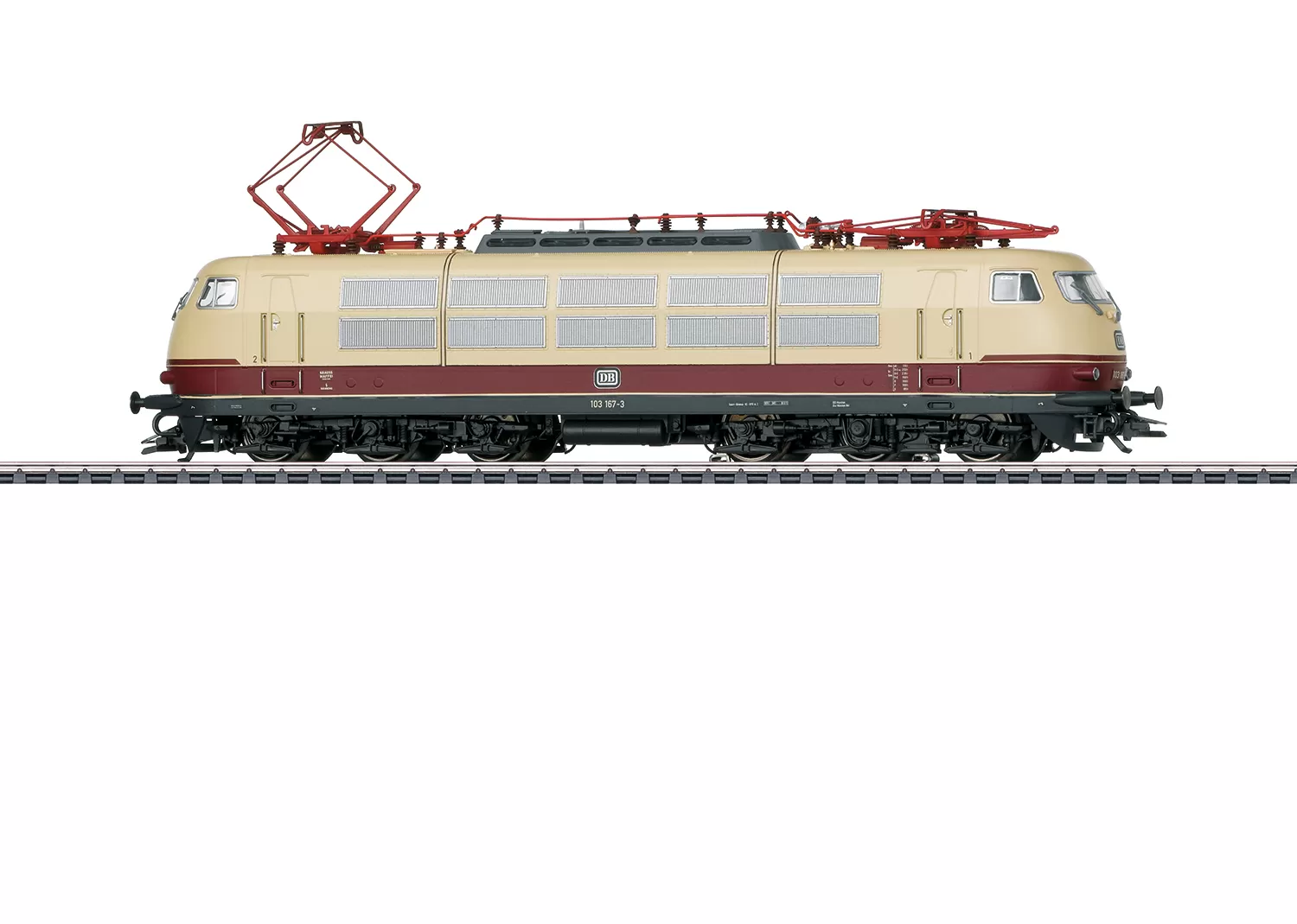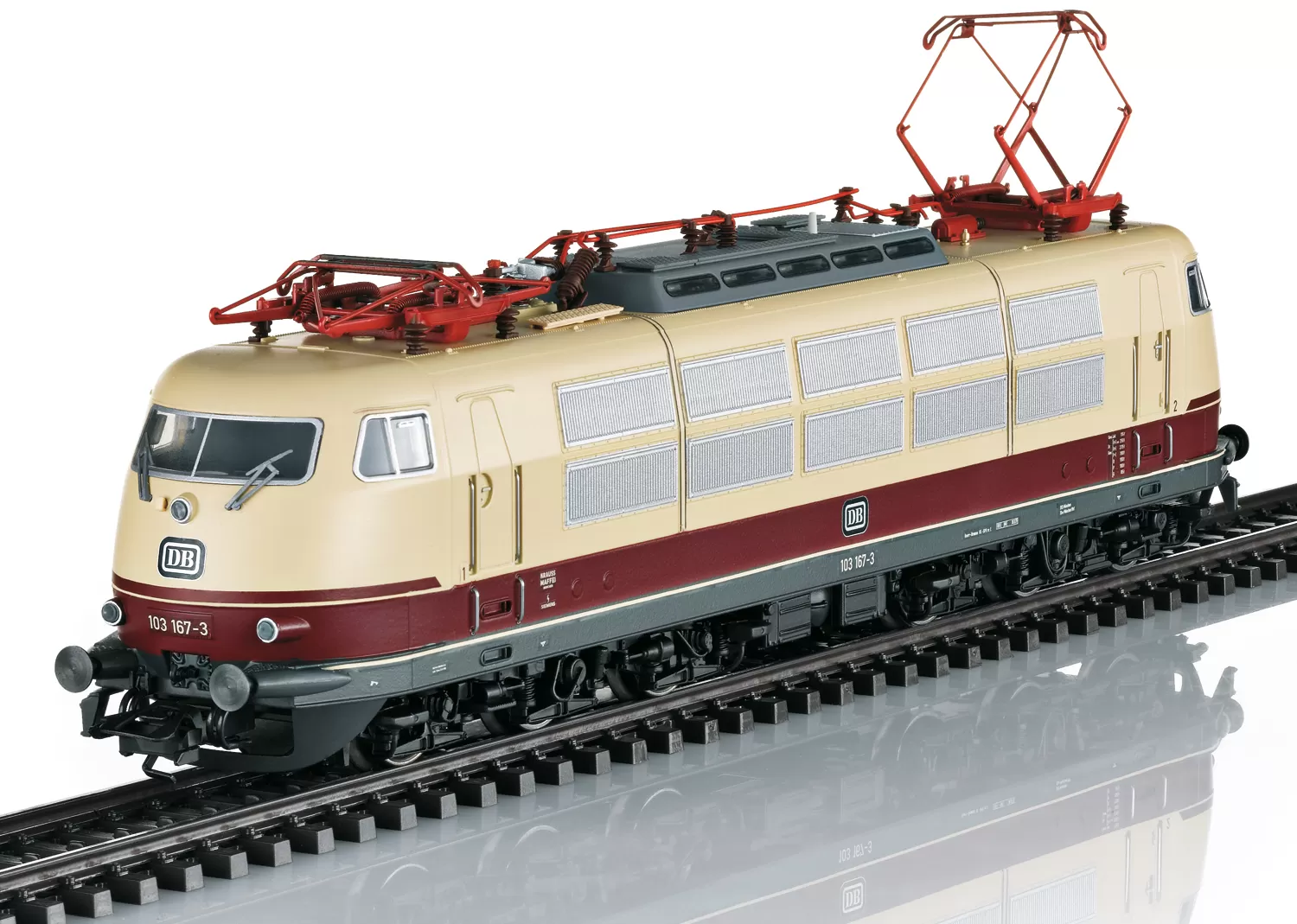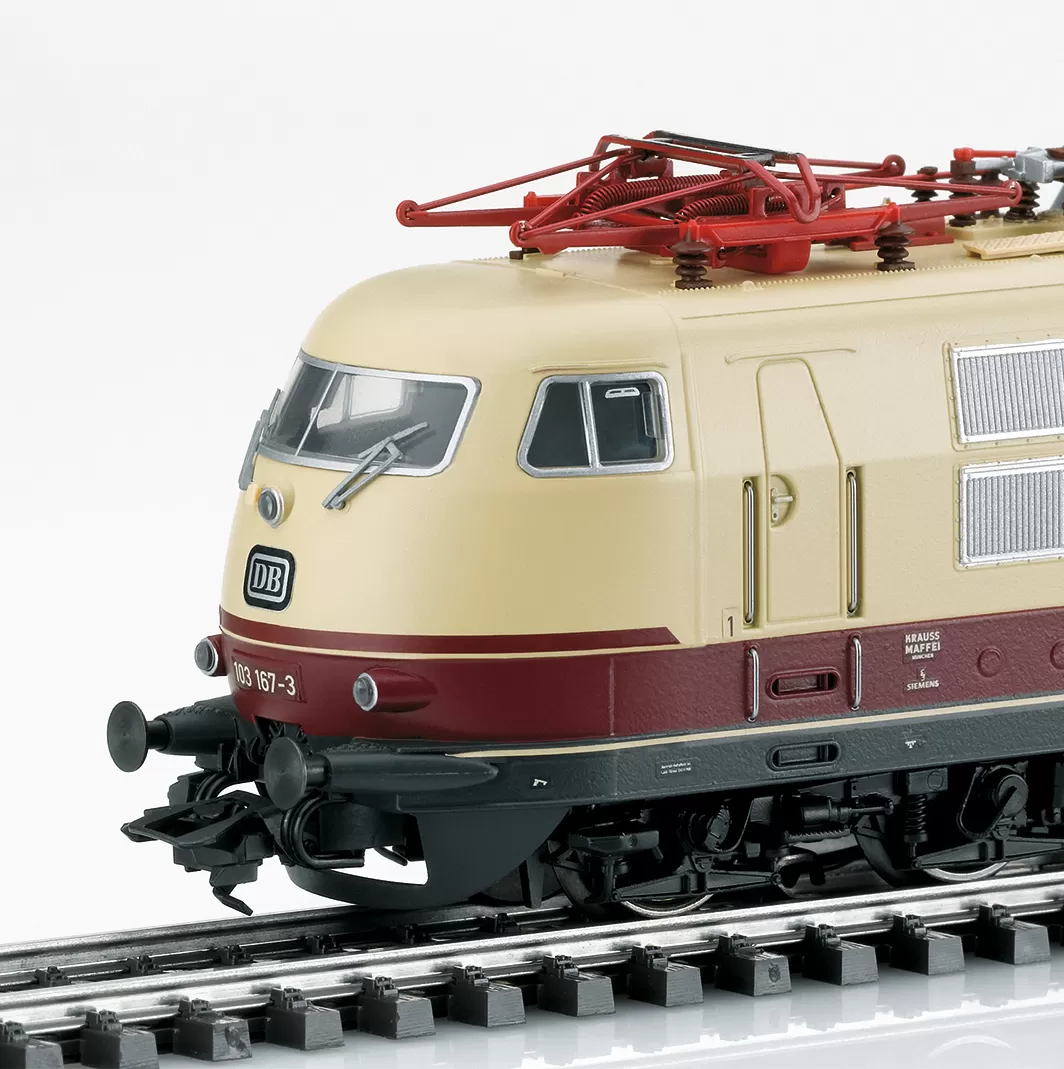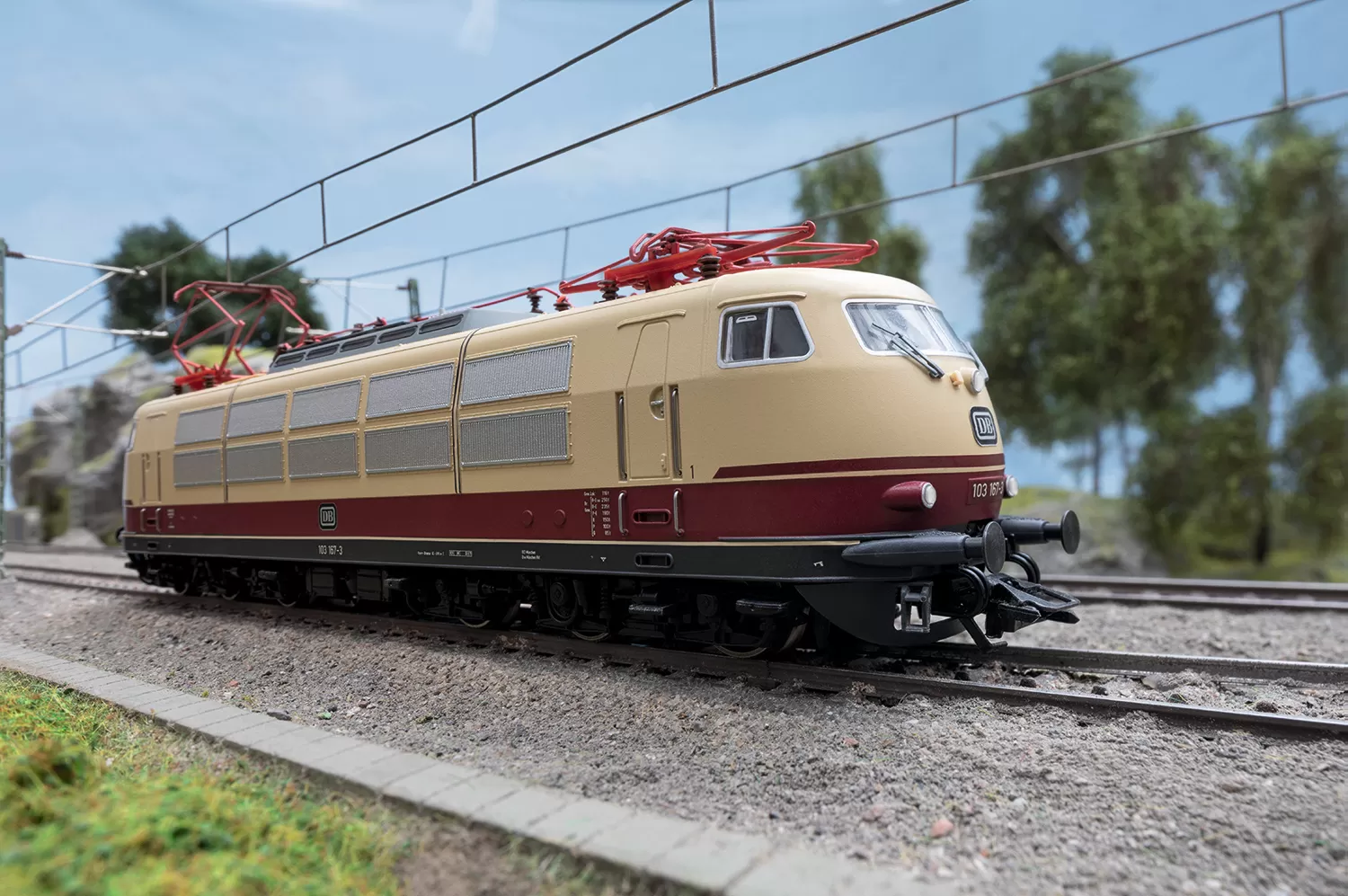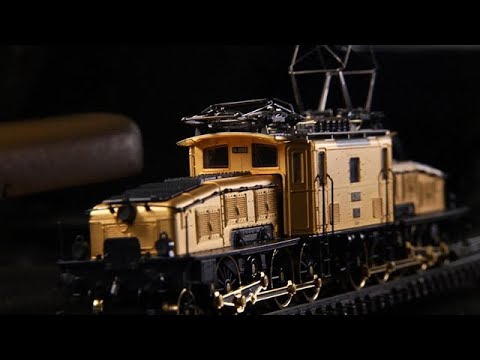Class 103.1 Electric Locomotive
Prototype: German Federal Railroad (DB) class 103.1 electric
locomotive. Version with "short" cabs, double-arm pantographs, end
skirting, and buffer cladding. Paint scheme in crimson/beige. Road
number 103 167-3. Based at Munich Main Station. The locomotive
looks as it did starting the end of August 1971 to May 1974.
Highlights:
- New tooling.
- Locomotive frame and body constructed of metal.
- Multi-protocol decoder with "World of Operation" function.
- Extensive light and sound functions.
- Pantographs can be controlled digitally.
- Cab lighting.
- Engine room lighting.
Model: The locomotive has an mfx+ digital decoder and extensive sound functions. It also has 5-pole controlled high-efficiency propulsion with a flywheel, centrally mounted. Two axles in each truck powered through cardan shafts. Traction tires. The triple headlights and dual red marker lights change over with the direction of travel, will work in conventional operation, and can be controlled digitally. The headlights at Locomotive End 2 and 1 can be turned off separately in digital operation. The cab lighting changes over with the direction of travel and can be controlled digitally. The engine room lighting can be controlled digitally. Maintenance-free warm white and red LEDs are used for the lighting. The double-arm pantographs can be controlled digitally. The locomotive has separately applied windshield wipers. It also has separately applied metal grab irons and roof conductors. Closed skirting, brake lines, plugs, and prototype couplers that can be mounted on the locomotive are included.
Prototype information: After delivery of four test locomotives of the new class E 03 (starting in 1968: 103.0) regular production was done starting in 1969 for the InterCity service (IC 71) planned to begin in 1971, but with new specifications. The effective load for TEE and IC trains at speeds of 200 km/h / 125 mph increased from 300 to 480 metric tons, and 800 metric ton D-Zug express trains had to be able to run at 160 km/h / 100 mph. The 145 regular production locomotives – now designated as the class 103.1 – had a basic design that followed that of the prototypes with a bridge frame, locomotive body consisting of five segments, and three-axle trucks. The same end shape was taken from the pre-production locomotives. The most striking thing externally was the doubling of the ventilation openings by a second five-part row of vent grills in the lower half of the side walls. This was caused by a larger air intake due to the greater performance of the locomotive. With a main transformer adjusted for maximum performance (continuous tractive effort output of 6,250 kilovolt amps) and type WBM 368/17f lightweight traction motors with a continuous rating of 1,240 kilowatts the result was a full increase in performance of 25.3% compared to the prototypes – an impressive 7,440 kilowatts or 10,116 horsepower. The last thirty units (road numbers 103 216-245) were equipped with a frame lengthened by 700 mm / 27-1/2" with larger cabs in order to realize the increase in size of the cramped cabs requested urgently by locomotive engineers. After being delivered in the years 1970 to 1974 the class 103.1 units immediately took over the new IC trains as well as the prestigious TEE trains that had now been partially integrated into the new IC network. Initially, the regular production units up to road number 103 215 were equipped with type DBS 54a double arm pantographs and type WB 15 Wanisch contact strips as well as upper arm shock absorbers. Yet this special design done for 200 km/h / 125 mph did not turn out well over time and caused catenary damage to the DB as well as the ÖBB network. The cause was thought to be contact pressure above the permissible 120 kilo-Newton / 26.97 kilo-pound force. The interim solution initially was partial replacement of the defective pantographs with the standard design type DBS 54 with a standard contact strip designed for a maximum speed of 160 km/h / 100 mph. Conversely, the last 30 units (road numbers 103 216-245) left the builder equipped with the single-arm type SBS 65 pantographs developed to production status in the meantime. Road numbers 103 101-215 were also supposed to be equipped with these single-arm pantographs, but the industry could not deliver such a quantity on such short notice. The DB thus decided on a more unconventional path and starting in 1975/76 had the "old" DBS 54 pantographs and still existing DBS 54a pantographs of the first production locomotives replaced by the SBS 65 single-arm pantographs of the class 111 just being delivered that was only 150 km/h / 94 mph fast. Several class 103 units were also equipped with the subsequently developed SBS 67, whose new design differed from the SBS 65 only in a larger spacing of the contact strips (400 instead of 350 mm / 15-3/4" instead of 13-3/4").
Highlights:
- New tooling.
- Locomotive frame and body constructed of metal.
- Multi-protocol decoder with "World of Operation" function.
- Extensive light and sound functions.
- Pantographs can be controlled digitally.
- Cab lighting.
- Engine room lighting.
Model: The locomotive has an mfx+ digital decoder and extensive sound functions. It also has 5-pole controlled high-efficiency propulsion with a flywheel, centrally mounted. Two axles in each truck powered through cardan shafts. Traction tires. The triple headlights and dual red marker lights change over with the direction of travel, will work in conventional operation, and can be controlled digitally. The headlights at Locomotive End 2 and 1 can be turned off separately in digital operation. The cab lighting changes over with the direction of travel and can be controlled digitally. The engine room lighting can be controlled digitally. Maintenance-free warm white and red LEDs are used for the lighting. The double-arm pantographs can be controlled digitally. The locomotive has separately applied windshield wipers. It also has separately applied metal grab irons and roof conductors. Closed skirting, brake lines, plugs, and prototype couplers that can be mounted on the locomotive are included.
Prototype information: After delivery of four test locomotives of the new class E 03 (starting in 1968: 103.0) regular production was done starting in 1969 for the InterCity service (IC 71) planned to begin in 1971, but with new specifications. The effective load for TEE and IC trains at speeds of 200 km/h / 125 mph increased from 300 to 480 metric tons, and 800 metric ton D-Zug express trains had to be able to run at 160 km/h / 100 mph. The 145 regular production locomotives – now designated as the class 103.1 – had a basic design that followed that of the prototypes with a bridge frame, locomotive body consisting of five segments, and three-axle trucks. The same end shape was taken from the pre-production locomotives. The most striking thing externally was the doubling of the ventilation openings by a second five-part row of vent grills in the lower half of the side walls. This was caused by a larger air intake due to the greater performance of the locomotive. With a main transformer adjusted for maximum performance (continuous tractive effort output of 6,250 kilovolt amps) and type WBM 368/17f lightweight traction motors with a continuous rating of 1,240 kilowatts the result was a full increase in performance of 25.3% compared to the prototypes – an impressive 7,440 kilowatts or 10,116 horsepower. The last thirty units (road numbers 103 216-245) were equipped with a frame lengthened by 700 mm / 27-1/2" with larger cabs in order to realize the increase in size of the cramped cabs requested urgently by locomotive engineers. After being delivered in the years 1970 to 1974 the class 103.1 units immediately took over the new IC trains as well as the prestigious TEE trains that had now been partially integrated into the new IC network. Initially, the regular production units up to road number 103 215 were equipped with type DBS 54a double arm pantographs and type WB 15 Wanisch contact strips as well as upper arm shock absorbers. Yet this special design done for 200 km/h / 125 mph did not turn out well over time and caused catenary damage to the DB as well as the ÖBB network. The cause was thought to be contact pressure above the permissible 120 kilo-Newton / 26.97 kilo-pound force. The interim solution initially was partial replacement of the defective pantographs with the standard design type DBS 54 with a standard contact strip designed for a maximum speed of 160 km/h / 100 mph. Conversely, the last 30 units (road numbers 103 216-245) left the builder equipped with the single-arm type SBS 65 pantographs developed to production status in the meantime. Road numbers 103 101-215 were also supposed to be equipped with these single-arm pantographs, but the industry could not deliver such a quantity on such short notice. The DB thus decided on a more unconventional path and starting in 1975/76 had the "old" DBS 54 pantographs and still existing DBS 54a pantographs of the first production locomotives replaced by the SBS 65 single-arm pantographs of the class 111 just being delivered that was only 150 km/h / 94 mph fast. Several class 103 units were also equipped with the subsequently developed SBS 67, whose new design differed from the SBS 65 only in a larger spacing of the contact strips (400 instead of 350 mm / 15-3/4" instead of 13-3/4").
Première annonce: 1er Trimestre 2019
Véhicules ferroviaires associés:
Prix de vente conseillé: 399.99 €

DCC (Digital)

mfx+ digital decoder

Integrated sound

Triple headlights and two red taillights alternating with the direction of travel

Interior LED lighting

Locomotive - metal frame and body

Length over buffers
224 mm

Coupler pocket and short coupling cinematic (NEM)
Forum de discussion

